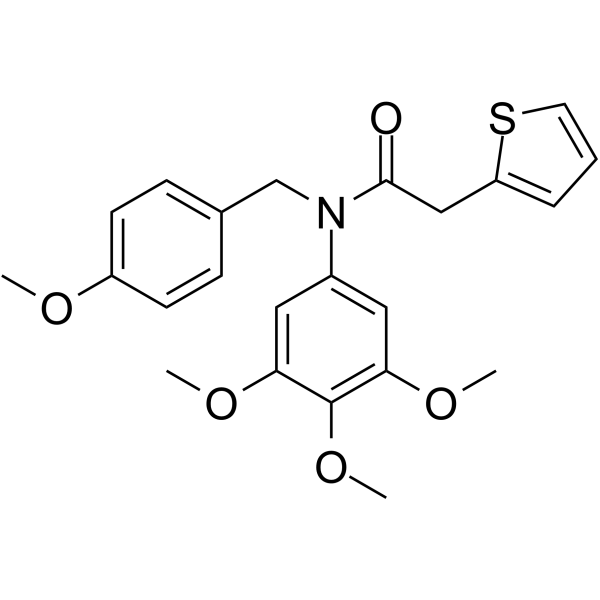Physicochemical Properties
| Molecular Formula | C23H25NO5S |
| Molecular Weight | 427.5133 |
| Exact Mass | 427.145 |
| CAS # | 2305757-96-2 |
| PubChem CID | 146673076 |
| Appearance | White to off-white solid powder |
| LogP | 4 |
| Hydrogen Bond Donor Count | 0 |
| Hydrogen Bond Acceptor Count | 6 |
| Rotatable Bond Count | 9 |
| Heavy Atom Count | 30 |
| Complexity | 514 |
| Defined Atom Stereocenter Count | 0 |
| SMILES | S1C([H])=C([H])C([H])=C1C([H])([H])C(N(C1C([H])=C(C(=C(C=1[H])OC([H])([H])[H])OC([H])([H])[H])OC([H])([H])[H])C([H])([H])C1C([H])=C([H])C(=C([H])C=1[H])OC([H])([H])[H])=O |
| InChi Key | CGVFRZMQURRQIE-UHFFFAOYSA-N |
| InChi Code | InChI=1S/C23H25NO5S/c1-26-18-9-7-16(8-10-18)15-24(22(25)14-19-6-5-11-30-19)17-12-20(27-2)23(29-4)21(13-17)28-3/h5-13H,14-15H2,1-4H3 |
| Chemical Name | N-[(4-methoxyphenyl)methyl]-2-thiophen-2-yl-N-(3,4,5-trimethoxyphenyl)acetamide |
| HS Tariff Code | 2934.99.9001 |
| Storage |
Powder-20°C 3 years 4°C 2 years In solvent -80°C 6 months -20°C 1 month |
| Shipping Condition | Room temperature (This product is stable at ambient temperature for a few days during ordinary shipping and time spent in Customs) |
Biological Activity
| Targets | NEDDylation[1] |
| ln Vitro | VII-31 (100 nM, 200 nM; 48 hours) reduces the cell viability of the gastric cell line MGC803 with an IC50 of 0.09±0.01 μM. Additionally, VII-31 inhibits MCF-7 and PC-3's ability to proliferate, with IC50 values of 0.10±0.006 and 1.15±0.28μM, respectively[1]. In G2/M phase, VII-31 (50-150 nM; 24 hr) stops the cycle of MGC803 cells[1]. Apoptosis is induced by VII-31 (50-150 nM; 48 hours) through both intrinsic and extrinsic pathways[1]. In MGC803 cells, VII-31 (50-150 nM; 24 hours) promotes NEDDylation[1]. Pro-apoptotic proteins FADD, Fasl, PIDD, Bax, and Bad are up-regulated by VII-31 (50-150 nM; 48 hours), whereas anti-apoptotic proteins Bcl-xL, Bcl-2, XIAP, and c-IAP1 are down-regulated[1]. |
| ln Vivo | While exhibiting no overt harm to mice, VII-31 suppresses the growth of tumors in vivo[1]. |
| Cell Assay |
Cell Viability Assay[1] Cell Types: Gastric cancer MGC803 cells Tested Concentrations: 100, 200 nM Incubation Duration: 48 hrs (hours) Experimental Results: Inhibited the cell viability in dose-dependent manner. Cell Cycle Analysis[1] Cell Types: MGC803 cells Tested Concentrations: 50, 100, 150 nM Incubation Duration: 24 hrs (hours) Experimental Results: Arrested cells in G2/M phase, and a clear sub-G1 peak was observed in the high dose group. Apoptosis Analysis[1] Cell Types: MGC803 cells Tested Concentrations: 50, 75, 100, and 150 nM Incubation Duration: 48 hrs (hours) Experimental Results: High dose (150 nM) treatment Dramatically elevated the early and late apoptosis rate to 92.8% from 4.8%. Western Blot Analysis[1] Cell Types: MGC803 cells Tested Concentrations: 50, 100, 150 nM Incubation Duration: 24 hrs (hours) Experimental Results: Resulted in NEDDylation activation of MGC803 cells, the NEDDylation of 3 important proteins NAE1, Ubc12 and CUL1 has been activated. |
| Animal Protocol |
Animal/Disease Models: Mice bearing MGC803 xenograft tumors[1] Doses: 50, 100, 150 mg/kg Route of Administration: subcutaneous (sc)injection; daily for 28 days Experimental Results: The mice had a much smaller tumor compared with vehicle control. The tumor volumes of middle/high dose treated mice at certain time points were evidently diminished comparing comparing with untreated group. |
| References |
[1]. Discovery of Novel Tertiary Amide Derivatives as NEDDylation Pathway Activators to Inhibit the Tumor Progression in Vitro and in Vivo. Eur J Med Chem. 2020 Apr 15;192:112153. |
Solubility Data
| Solubility (In Vitro) | DMSO : 250 mg/mL (584.78 mM) |
| Solubility (In Vivo) |
Solubility in Formulation 1: ≥ 2.08 mg/mL (4.87 mM) (saturation unknown) in 10% DMSO + 40% PEG300 + 5% Tween80 + 45% Saline (add these co-solvents sequentially from left to right, and one by one), clear solution. For example, if 1 mL of working solution is to be prepared, you can add 100 μL of 20.8 mg/mL clear DMSO stock solution to 400 μL PEG300 and mix evenly; then add 50 μL Tween-80 to the above solution and mix evenly; then add 450 μL normal saline to adjust the volume to 1 mL. Preparation of saline: Dissolve 0.9 g of sodium chloride in 100 mL ddH₂ O to obtain a clear solution. Solubility in Formulation 2: 2.08 mg/mL (4.87 mM) in 10% DMSO + 90% (20% SBE-β-CD in Saline) (add these co-solvents sequentially from left to right, and one by one), suspension solution; with ultrasonication. For example, if 1 mL of working solution is to be prepared, you can add 100 μL of 20.8 mg/mL clear DMSO stock solution to 900 μL of 20% SBE-β-CD physiological saline solution and mix evenly. Preparation of 20% SBE-β-CD in Saline (4°C,1 week): Dissolve 2 g SBE-β-CD in 10 mL saline to obtain a clear solution. Solubility in Formulation 3: ≥ 2.08 mg/mL (4.87 mM) (saturation unknown) in 10% DMSO + 90% Corn Oil (add these co-solvents sequentially from left to right, and one by one), clear solution. For example, if 1 mL of working solution is to be prepared, you can add 100 μL of 20.8 mg/mL clear DMSO stock solution to 900 μL of corn oil and mix evenly. (Please use freshly prepared in vivo formulations for optimal results.) |
| Preparing Stock Solutions | 1 mg | 5 mg | 10 mg | |
| 1 mM | 2.3391 mL | 11.6956 mL | 23.3913 mL | |
| 5 mM | 0.4678 mL | 2.3391 mL | 4.6783 mL | |
| 10 mM | 0.2339 mL | 1.1696 mL | 2.3391 mL |
